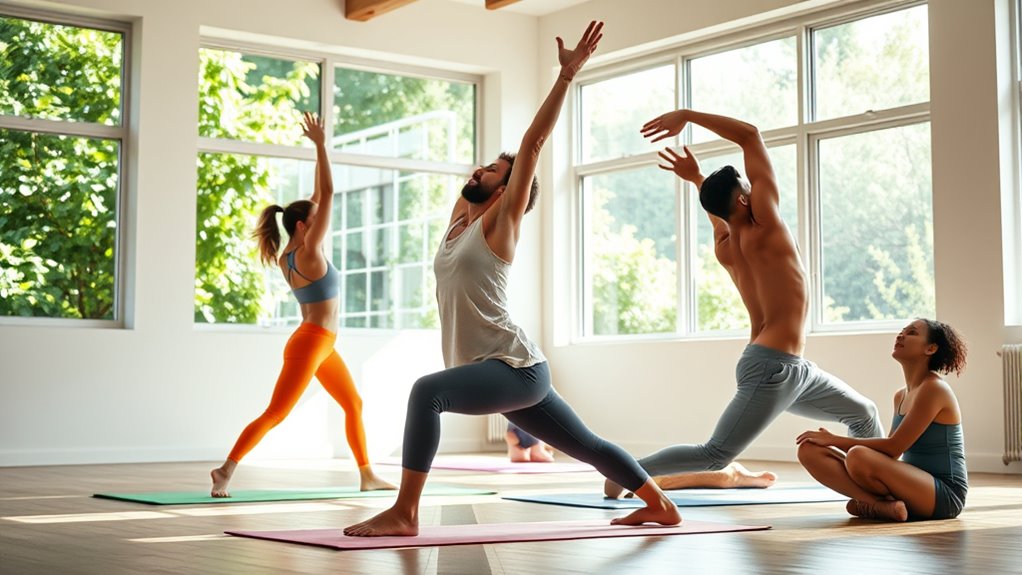To keep moving confidently, incorporate dynamic stretching routines into your warm-up. Focus on controlled movements like leg swings, arm circles, and torso twists that activate muscles and improve flexibility without overstressing them. These exercises boost blood flow, prepare your joints, and reduce injury risks. Doing so consistently before workouts or sports helps you perform better and stay injury-free. Keep going, and you’ll discover more ways to enhance your flexibility and keep your body energized.
Key Takeaways
- Incorporate dynamic stretches like leg swings and arm circles into warm-ups to enhance blood flow and muscle readiness.
- Focus on key muscle groups such as hamstrings, hips, shoulders, and calves to improve overall mobility.
- Perform stretches smoothly without bouncing to prevent overstressing muscles and reduce injury risk.
- Use routine stretching before workouts or activities to boost performance and prepare muscles for movement.
- Consistently practice dynamic flexibility exercises to increase muscle responsiveness, stability, and long-term mobility.

Stretching routines are vital for maintaining flexibility, preventing injuries, and enhancing overall performance. When you incorporate dynamic flexibility exercises into your warm-up, you prepare your muscles and joints for the activity ahead. Unlike static stretches, which involve holding a position, dynamic stretches involve moving parts of your body through a full range of motion. This active approach increases blood flow, warms up your muscles, and activates your nervous system, making your body more responsive and less prone to strains or tears. By focusing on dynamic flexibility, you can better mimic the movements you’ll perform during your workout or sport, guaranteeing your muscles are ready to operate efficiently. This proactive method not only boosts your performance but also plays an essential role in injury prevention. When your muscles are warmed up and flexible, they’re less likely to tighten or become overstressed, reducing the risk of pulls, strains, or other common injuries.
To implement an effective routine, start with gentle, controlled movements like leg swings, arm circles, or torso twists. These exercises should be performed smoothly, without bouncing or jerking, to avoid overstressing your muscles. As you become more comfortable, gradually increase the range of motion and speed, always listening to your body. Focus on key muscle groups that are involved in your activity—hamstrings, hip flexors, shoulders, and calves, for example. Incorporating the benefits of high refresh rates can also contribute to a more seamless and engaging warm-up experience, especially for gamers or athletes who value fluid motion. Integrating dynamic flexibility into your warm-up takes just a few minutes but can notably improve your readiness and safety during physical activity. Remember, the goal is to loosen up your muscles without overstretching or causing discomfort.
Consistently practicing dynamic flexibility exercises helps your muscles adapt over time, promoting better joint mobility and muscle elasticity. This flexibility not only supports injury prevention but also enhances your ability to perform complex movements with ease. When your muscles are more responsive, you’ll notice improvements in your agility, balance, and overall athleticism. Furthermore, a proper warm-up that emphasizes dynamic flexibility can boost your confidence, as you’ll feel more prepared and less anxious about potential injuries. Make it a habit to incorporate these routines before every workout, sport, or physical activity to maximize benefits. Staying committed to dynamic flexibility exercises ensures you stay loose, safe, and ready to move freely, no matter what activity you pursue.
Frequently Asked Questions
How Often Should I Stretch Daily for Optimal Benefits?
You should aim to stretch daily for about 10-15 minutes to see flexibility improvement and prevent injuries. Consistent stretching helps keep your muscles supple and reduces the risk of strains. Focus on major muscle groups and hold each stretch for 15-30 seconds. Incorporating stretching into your routine regularly guarantees you stay limber, improve overall mobility, and lower your chances of injury during physical activities.
Are There Any Stretches I Should Avoid?
Many believe all stretches are safe, but stretching myths persist. You should avoid dangerous stretches that put undue strain on your joints or muscles, especially those involving bouncing or overstretching. For instance, deep backbends or neck stretches without proper guidance can cause injury. Always listen to your body, and consult a professional if you’re unsure. Not all stretches are safe for everyone, so be cautious and prioritize proper technique.
What’s the Best Time of Day to Stretch?
The best time of day to stretch depends on your goals. If you’re aiming for morning flexibility, stretching in the early hours can boost circulation and loosen muscles. For evening relaxation, winding down with gentle stretches helps reduce tension and prepare your body for rest. Listen to your body and choose a time that feels best for you, making stretching a beneficial part of your daily routine.
Can Stretching Help With Specific Injuries?
Stretching can be a game-changer when it comes to injury prevention and muscle recovery. While it won’t fix every injury, it helps keep your muscles flexible and less prone to strains. If you’re dealing with specific injuries, consult a healthcare professional first, but gentle stretching can support your healing process. Think of it as giving your body a head start—staying limber keeps you ahead of the game.
How Long Should Each Stretching Session Last?
For each stretching session, aim for 10 to 15 minutes, following duration guidelines that suit your flexibility level. Your session planning should include holding each stretch for about 15 to 30 seconds, repeating them 2 to 4 times. This approach helps improve flexibility and prevents injury. Adjust the duration based on your needs, but consistency is key to seeing benefits from your stretching routine.
Conclusion
So, stay steady, stretch simply, and savor the sensation of sustained mobility. Incorporate these routines regularly to reinforce flexibility, reduce risks, and rejuvenate your joints. Remember, consistency creates comfort, and commitment cultivates confidence. Keep moving mindfully, and make stretching a seamless part of your daily schedule. With a little dedication and discipline, you’ll develop a dynamic, durable, and delightful dance of daily movement. Stay strong, stay supple, and keep stretching!








